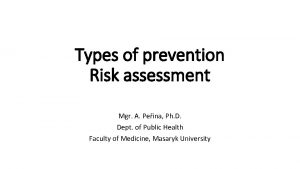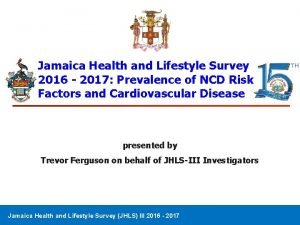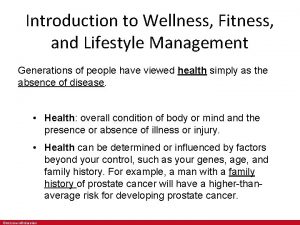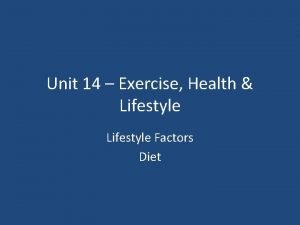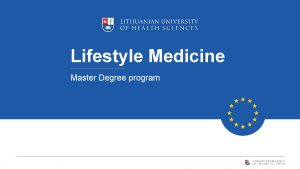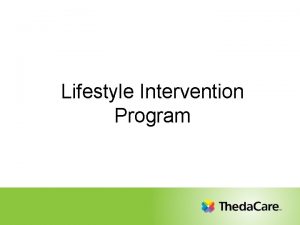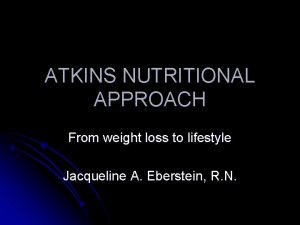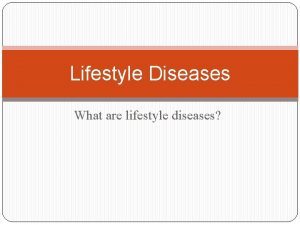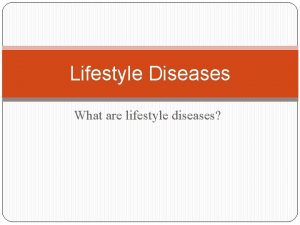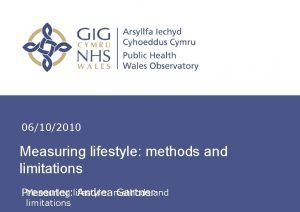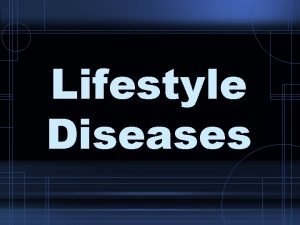LIFESTYLE MODIFICATION IN THE PREVENTION OF TYPE 2




























































- Slides: 60

LIFESTYLE MODIFICATION IN THE PREVENTION OF TYPE 2 DIABETES: THE EXPERIENCE WITH THE DIABETES PREVENTION PROGRAM AND LOOK Edward S Horton, MD AHEAD STUDIES Joslin Diabetes Center Harvard Medical School Boston, MA Source: www. myhealthywaist. org

Global Projections for the Diabetes Epidemic: 2003 -2025 (in Millions) 48. 4 23. 0 58. 6 75. 8 Europe 36. 2 North America 39. 4 21% 19. 2 57% Western 43. 0 pacific Eastern Mediterranean and Middle East 105% 81. 6 39. 3 7. 1 14. 2 2003 2025 26. 2 South and Central 85% America 15. 0 76% South-East Asia 108% Africa 111% 333 194 World 72% Adapted from Diabetes Atlas Committee. Diabetes Atlas 2 nd Edition: IDF 2003 Source: www. myhealthywaist. org

Global Projections for the Diabetes Epidemic: 2011 -2030 (in Millions) 187. 9 131. 9 52. 6 64. 0 Western Pacific Europe 37. 7 51. 2 North America and Carribean 22% 32. 8 120. 9 59. 7 Middle East and North Africa 36% 42% 71. 4 South-East Asia 83% 69% 28. 0 14. 7 2011 2030 25. 1 39. 9 South and Central America 59% Africa 90% 551. 8 366. 2 World 51% Adapted from Diabetes Atlas Committee. Diabetes Atlas 5 th Edition: IDF 2011 Source: www. myhealthywaist. org

Obesity Is the Primary Risk Factor for Type 2 Diabetes Age-adjusted relative risk of type 2 diabetes 50 100 Men 1 42. 1 Relative risk 40 93. 2 Women 2 75 30 50 40. 3 20 11. 6 25 10 2. 2 0 8. 1 1. 0 <23 25 31 35 0 1. 0 <22 25 31 35 Body mass index (kg/m 2) 1 Chan 2 Colditz Source: www. myhealthywaist. org JM et al. Diabetes Care 1994; 17: 961 -9 G et al. Ann Intern Med 1995; 122: 481 -6

The Dual Epidemic: Obesity and Diabetes q 65% of adult Americans are overweight (BMI >25 kg/m 2) and 32% are obese (BMI >30 kg/m 2). q 34% have the metabolic syndrome (NCEP-ATP III criteria). q There are now an estimated 25. 8 million people with diabetes in the USA (11. 3% of adults) and 79 million with pre -diabetes (IFG/IGT). q The lifetime risk of developing diabetes for people born in 2000 is 33% for men and 39% for women. For Hispanic women it is 50%. q In this population cardiovascular disease is the major cause of mortality. IFG: Impaired fasting glucose IGT: Impaired glucose tolerance Source: www. myhealthywaist. org

What is driving the dual epidemic? Changes in our lifestyle! Source: www. myhealthywaist. org

Diabetes Metabolic syndrome? Source: www. myhealthywaist. org

Prevention and Treatment of Diabetes A major goal of treatment of pre -diabetes and diabetes is to prevent both the microvascular and the macrovascular complications! Source: www. myhealthywaist. org

Trials to Prevent / Delay Progression from Impaired Glucose Tolerance to Type 2 Diabetes Lifestyle changes Medications § Malmo Study § Diabetes Prevention Program: metformin, (troglitazone) § TRIPOD: troglitazone § STOP-NIDDM: acarbose § NAVIGATOR: nateglinide and valsartan § DREAM: rosiglitazone and ramipril § XENDOS: orlistat § ORIGIN: glargine insulin § ACT NOW: pioglitazone § Voglibose Study § Da Qing Study § Finnish Diabetes Prevention Study § Diabetes Prevention Program ACT NOW: Actos Now for Prevention of Diabetes DREAM: Diabetes Reduction Approaches with Ramipril and Rosiglitazone NAVIGATOR: Nateglinide and Valsartan in Impaired Glucose Tolerance Outcomes Research ORIGIN: Outcomes Reduction with Initial Glargine Introduction STOP-NIDDM: Study to Prevent Non–Insulin-Dependent Diabetes Mellitus TRIPOD: Troglitazone in Prevention of Diabetes Study XENDOS: Xenical in the Prevention of Diabetes in Obese Subjects Source: www. myhealthywaist. org

Summary of Medication Trials to Prevent Type 2 Diabetes AGIs (STOP-NIDDM, Voglibose) q Metformin (Diabetes Prevention Program) q TZDs (TRIPOD, DREAM, ACT NOW) q RRR 25 -40% 31% 55 -80% The major concerns are long-term safety, tolerance, efficacy and cost-effectiveness of medications: § AGIs: gastrointestinal side effects § Metformin: gastrointestinal side effects § TZDs: weight gain, fluid retention, cardiovascular disease, fractures ACT NOW: Actos Now for Prevention of Diabetes AGIs: alpha-glucosidase inhibitors DREAM: Diabetes Reduction Approaches with Ramipril and Rosiglitazone RRR: Relative risk reduction STOP-NIDDM: Study to Prevent Non–Insulin-Dependent Diabetes Mellitus TRIPOD: Troglitazone in Prevention of Diabetes Study TZDs: thiazolidinediones Source: www. myhealthywaist. org

The Diabetes Prevention Program (DPP) A randomized clinical trial to prevent type 2 diabetes in persons at high risk Sponsored by the NIH, NIDDK, NIA, NICHD, IHS, CDC, ADA and other agencies and corporations Source: www. myhealthywaist. org

Study Population Caucasian African-American Hispanic-American Asian American Indian Caucasian African-American Hispanic-American Asian-American & Pacific Islander American Indian 1768 645 508 142 171 Total 3234 Adapted from Knowler WC et al. N Engl J Med 2002; 346: 393 -403 Source: www. myhealthywaist. org

Study Interventions Eligible participants Randomized Standard lifestyle recommendations Intensive lifestyle Metformin Placebo (n=1079) (n=1073) (n=1082) Source: www. myhealthywaist. org

Lifestyle & Metformin Interventions Intensive lifestyle goals Reduction of fat and calorie intake q Physical activity at least 150 minutes/week q Achieve and maintain at least 7% weight loss q Metformin goals q Metformin 850 mg twice daily Source: www. myhealthywaist. org

Study Timeline 2002 DPPOS began 1999 1996 DPP recruitment began DPP enrollment completed 1998 2009 2013 DPPOS midpoint results 2001 DPPOS visits end DPP results 2000 2002 2004 2006 June 1996 2008 2010 2012 December 2013 DPP: Diabetes Prevention Program DPPOS: Diabetes Prevention Program Outcomes Study Adapted from Diabetes Prevention Program Research Group Lancet 2009; 374: 1677 -86 Source: www. myhealthywaist. org

Mean Weight Change Placebo Metformin Lifestyle Adapted from Knowler WC et al. N Engl J Med 2002; 346: 393 -403 Source: www. myhealthywaist. org

Mean Change in Leisure Physical Activity Placebo Metformin Lifestyle Adapted from Knowler WC et al. N Engl J Med 2002; 346: 393 -403 Source: www. myhealthywaist. org

Incidence of Diabetes Cumulative incidence of diabetes (%) Risk reduction 31% by metformin 58% by lifestyle Placebo Metformin Lifestyle Study year Placebo: n=1082 Metformin: n=1073, p<0. 001 vs. placebo Lifestyle: n=1079, p<0. 001 vs. metformin, p<0. 001 vs. placebo Adapted from Orchard TJ et al. Ann Intern Med 2005; 142: 611 -9 Source: www. myhealthywaist. org

Metabolic Syndrome NCEP-ATP III Clinical Criteria (3 of 5) Atherogenic dyslipidemia § Triglycerides ≥ 1. 69 mmol/l § HDL cholesterol Men: <1. 03 mmol/l Women: <1. 29 mmol/l Elevated blood pressure ≥ 130/85 mm. Hg Obesity (esp. abdominal obesity) Genetic variation in cardiovascular disease risk factor regulation Insulin resistance Waist circumference Men: ≥ 102 cm (40 in) Women: ≥ 88 cm (35 in Proinflammatory state Pro-thrombotic state Fasting glucose ≥ 5. 6 mmol/l (modified) Adapted from Expert Panel on Detection, Evaluation, and Treatment of High Blood Cholesterol in Adults JAMA 2001; 285: 2486 -97 Source: www. myhealthywaist. org

Prevalence of Metabolic Syndrome at Randomization q 1711 (53%) of the 3234 participants had the syndrome at randomization. q Prevalence of the syndrome did not vary by gender or age group (<45, 45 -64, 65+ years). q Prevalence did vary by ethnicity, being lowest in Asians (41%) and highest in Caucasians (57%). q Prevalence of the individual components did vary by ethnicity and by age group. Source: www. myhealthywaist. org

Cumulative Incidence of Metabolic Syndrome by Treatment Group Cumulative incidence of metabolic syndrome (%) Risk reduction: 17%* by metformin 41%** by lifestyle Lifestyle vs. metformin 29%** Placebo n=490 Metformin n=503 Lifestyle n=530 0 * p<0. 05 ** p<0. 001 1 2 3 4 Time since randomization (years) Adapted from Orchard TJ et al. Ann Intern Med 2005; 142: 611 -9 Source: www. myhealthywaist. org

Three-Year Incidence of Components by Treatment Group Placebo Metformin (%) Lifestyle (%) Low HDL cholesterol 33 70 15* 67 8* 68 High triglycerides 27 30 18* High fasting plasma glucose 40 29* 28* High blood pressure 41 44 35* High waist circumference *p<0. 001 comparison vs. placebo Adapted from Orchard TJ et al. Ann Intern Med 2005; 142: 611 -9 Source: www. myhealthywaist. org

Key Findings q Hypertension was present in 30% of subjects at baseline; over 3 years it increased in the placebo and metformin groups, but significantly decreased in the intensive lifestyle group. q Triglycerides decreased in all groups, but fell significantly more in intensive lifestyle group. q Intensive lifestyle group significantly increased HDL cholesterol and decreased LDL phenotype B. q After 3 years, the use of medications to achieve targets for hypertension was 27 -28% less and for dyslipidemia was 25% less in the intensive lifestyle group. Source: www. myhealthywaist. org

Study Timeline 2002 DPPOS began 1999 1996 DPP recruitment began DPP enrollment completed 1998 2009 2013 DPPOS midpoint results 2001 DPPOS visits end DPP results 2000 2002 2004 2006 June 1996 2008 2010 2012 December 2013 DPPOS midpoint follow-up after 7 years Time since original DPP randomization (10 years) DPP: Diabetes Prevention Program DPPOS: Diabetes Prevention Program Outcomes Study Adapted from Diabetes Prevention Program Research Group Lancet 2009; 374: 1677 -86 Source: www. myhealthywaist. org

Diabetes Prevention Program Outcomes Study (DPPOS) Goals q Diabetes delay or prevention. q Prevention of diabetes complications such as kidney, eye and nerve problems, and heart disease. Source: www. myhealthywaist. org

Diabetes Prevention Program Outcomes Study (DPPOS) Treatments q Original Placebo group § q HELP classes four times a year Original Metformin group Metformin 850 mg twice daily § HELP classes four times a year § q Original Lifestyle group HELP classes four times a year § Boost lifestyle classes twice a year § Source: www. myhealthywaist. org

Change in weight (kg) Weight Change Over Time 0 -2 -4 Placebo Metformin Lifestyle -6 -8 0 2 4 6 8 10 Year since DPP randomization Adapted from Diabetes Prevention Program Research Group Lancet 2009; 374: 1677 -86 Source: www. myhealthywaist. org

Cumulative incidence (%) Diabetes Prevention Program Outcomes Study (DPPOS) Incidence of Diabetes 60 Placebo Metformin Lifestyle 50 40 30 20 10 0 0 2 4 6 8 10 Year since DPP randomization Adapted from Diabetes Prevention Program Research Group Lancet 2009; 374: 1677 -86 Source: www. myhealthywaist. org

Cumulative incidence (%) Diabetes Prevention Program Outcomes Study (DPPOS) Incidence of Diabetes 60 Placebo Metformin Lifestyle 50 40 30 20 Risk reduction: 10 18% with metformin 34% with lifestyle 0 0 2 4 6 8 10 Year since DPP randomization Adapted from Diabetes Prevention Program Research Group Lancet 2009; 374: 1677 -86 Source: www. myhealthywaist. org

Crude rate per 100 person-years Diabetes Prevention Program (DPP) vs. Diabetes Prevention Program Outcomes Study (DPPOS) Diabetes Rates Placebo Metformin Lifestyle Adapted from Diabetes Prevention Program Research Group Lancet 2009; 374: 1677 -86 Source: www. myhealthywaist. org

Diabetes Development in Diabetes Prevention Program Outcomes Study (DPPOS) q Original Lifestyle participants continue to develop diabetes at the lower rate they developed diabetes during Diabetes Prevention Program (DPP). q Original Placebo and Metformin participants have lowered their rate of diabetes development to a similar rate as the Lifestyle group. Source: www. myhealthywaist. org

Diabetes Prevention Program Outcomes Study (DPPOS) Diabetes Risk Reduction q Delay in diabetes onset after 10 years of follow-up: § 4 years for Lifestyle group § 2 years for Metformin group q The lower rate of diabetes development for lifestyle and metformin during Diabetes Prevention Program (DPP) means: § Original Lifestyle participants have a 34% lower risk of diabetes compared to Placebo participants. § Original Metformin participants have a 18% lower risk of diabetes compared to Placebo participants. Source: www. myhealthywaist. org

Use of Anti-Diabetic Medicines Use of antidiabetic medications (%) 30 Placebo Metformin Lifestyle 25 20 15 10 5 0 0 2 4 6 8 10 Year since DPP randomization Adapted from Diabetes Prevention Program Research Group Lancet 2009; 374: 1677 -86 Source: www. myhealthywaist. org

Look AHEAD Clinical Trial AIM: To determine whether cardiovascular morbidity and mortality in persons with type 2 diabetes can be reduced through intensive lifestyle intervention aimed at producing and maintaining weight loss. Source: www. myhealthywaist. org

Primary Outcome q The incidence rate of the first post-randomization occurrence of a composite outcome, including: § § cardiovascular death (fatal myocardial infarction and stroke) nonfatal myocardial infarction nonfatal stroke hospitalization for angina Over 13. 5 -year follow-up is reduced in the Intensive Lifestyle Intervention group compared to Diabetes Support and Education group. Source: www. myhealthywaist. org

Other Outcomes q q q q All-cause mortality Cardiovascular disease risk factors Costs and cost effectiveness Diabetes control and complications General health Hospitalizations Quality of life and psychological outcomes Source: www. myhealthywaist. org

Look AHEAD Interventions q Intensive Lifestyle Intervention (ILI) q Diabetes Support & Education (DSE) Source: www. myhealthywaist. org

Lifestyle Intervention Phase I: Weight Loss Induction q Months 1 -6 q Weekly contact 3 group sessions/month § 1 individual session/month § q Personal weight loss goal =10% q Study weight loss goal ≥ 7% Adapted from Look AHEAD Research Group Control Clin Trials 2003; 24: 610 -28 Source: www. myhealthywaist. org

Recommendations q Dietary intake § § § q 1200 -1500 kcal/day <250 lbs (<113. 5 kg) 1500 -1800 kcal/day ≥ 250 lbs (≥ 113. 5 kg) ≤ 30% calories from fat meal replacements menu plans Physical activity § § § gradual increase 175 min/week 10, 000 steps/day (approx. 5 miles) Adapted from Look AHEAD Research Group Control Clin Trials 2003; 24: 610 -28 Source: www. myhealthywaist. org

Lifestyle Intervention Phase II: Weight Loss Maintenance q Months 7 -12 q Reduced contact § § § q 2 group sessions/month 1 individual session/month 2 face-to-face contacts/month required; 3 recommended Individual weight loss goal § § continue weight loss if <10% weight maintenance if ≥ 10% Adapted from Look AHEAD Research Group Control Clin Trials 2003; 24: 610 -28 Source: www. myhealthywaist. org

Diabetes Support and Education q 3 -4 meetings/year to promote retention q Health education topics § diet § exercise § social support Adapted from Look AHEAD Research Group Control Clin Trials 2003; 24: 610 -28 Source: www. myhealthywaist. org

Baseline Characteristics of Participants Lifestyle intervention (N=2570) Diabetes support and education (N=2575) Women (%) 59. 3 59. 6 Age (years) 58. 6 58. 9 15 16 Baseline BMI (kg/m 2) 35. 9 36. 0 Baseline weight (kg) 100. 5 100. 9 Baseline waist (cm) 113. 8 114. 1 15 14 Insulin users (%) History of prior cardiovascular disease event (%) Adapted from: Look AHEAD Research Group Obesity (Silver Spring) 2006; 14: 737 -52 and Look AHEAD Research Group Diabetes Care 2007; 30: 1374 -1383 Source: www. myhealthywaist. org

Assessments q Annual clinic visits § § q Weight, blood pressure, lipids. Fitness with maximum treadmill test at baseline and sub-max at years 1 and 4. Participant’s own physician is responsible for medical care and changes in medications. Adapted from Look AHEAD Research Group Control Clin Trials 2003; 24: 610 -28 Source: www. myhealthywaist. org

Weight Loss at 1 Year 0 ILI 0. 7% -1 Change in weight (%) DSE -2 -3 -4 -5 -6 ILI: Intensive Lifestyle Intervention DSE: Diabetes Support & Education -7 -8 -9 8. 6% p<0. 0001 Adapted from Look AHEAD Research Group Diabetes Care 2007; 30: 1374 -1383 Source: www. myhealthywaist. org

Mean fitness change (%) Fitness Change at 1 Year 20. 9 ILI: Intensive Lifestyle Intervention DSE: Diabetes Support & Education 15. 9 10. 8 5. 8 DSE ILI Unadjusted p<0. 001 DSE ILI Adjusted for 1 year weight change p<0. 001 Adapted from Look AHEAD Research Group Diabetes Care 2007; 30: 1374 -1383 Source: www. myhealthywaist. org

1 -Year Changes in Markers of Diabetes Control Markers of diabetes control ILI DSE p value Hemoglobin A 1 c (%), Baseline Hemoglobin A 1 c (%), Year 1 – Baseline 7. 25 6. 61 -0. 64 7. 29 7. 15 -0. 14 0. 26 <0. 001 Fasting glucose (mmol/l), Baseline Fasting glucose (mmol/l), Year 1 – Baseline 8. 4 7. 2 -1. 2 8. 5 8. 1 -0. 4 0. 21 <0. 001 Diabetes medications (%), Baseline Diabetes medications (%), Year 1 – Baseline 86. 5 78. 6 -7. 8 86. 5 88. 7 2. 2 0. 93 <0. 001 ILI: Intensive Lifestyle Intervention DSE: Diabetes Support & Education Adapted from Look AHEAD Research Group Diabetes Care 2007; 30: 1374 -1383 Source: www. myhealthywaist. org

1 -Year Changes in Markers of Blood Pressure (BP) Control Markers of blood pressure control ILI DSE p value Systolic BP (mm. Hg), Baseline Systolic BP (mm. Hg), Year 1 – Baseline 128. 2 121. 4 -6. 8 129. 4 126. 6 -2. 8 0. 01 <0. 001 Diastolic BP (mm. Hg), Baseline Diastolic BP (mm. Hg), Year 1 – Baseline 69. 9 67. 0 -3. 0 70. 4 68. 6 -1. 8 0. 11 <0. 001 Antihypertensive medications (%), Baseline Antihypertensive medications (%), Year 1 – Baseline 75. 3 75. 2 -0. 1 73. 7 75. 9 2. 2 0. 23 0. 54 0. 02 ILI: Intensive Lifestyle Intervention DSE: Diabetes Support & Education Adapted from Look AHEAD Research Group Diabetes Care 2007; 30: 1374 -1383 Source: www. myhealthywaist. org

1 -Year Changes in Markers of Lipid Control Markers of lipid control ILI DSE p value LDL cholesterol (mmol/l), Baseline LDL cholesterol (mmol/l), Year 1 – Baseline 2. 90 2. 77 -0. 13 2. 91 2. 76 -0. 15 0. 78 0. 74 0. 49 HDL cholesterol (mmol/l), Baseline HDL cholesterol (mmol/l), Year 1 – Baseline 1. 12 1. 21 0. 09 1. 13 1. 16 0. 04 0. 80 <0. 001 Triglycerides (mmol/l), Baseline Triglycerides (mmol/l), Year 1 – Baseline 2. 06 1. 72 -0. 34 2. 03 1. 87 -0. 16 0. 38 <0. 001 Lipid-lowering medications (%), Baseline Lipid-lowering medications (%), Year 1 – Baseline 49. 4 53. 0 3. 7 48. 4 57. 8 9. 4 0. 52 <0. 001 ILI: Intensive Lifestyle Intervention DSE: Diabetes Support & Education Adapted from Look AHEAD Research Group Diabetes Care 2007; 30: 1374 -1383 Source: www. myhealthywaist. org

Four-Year Results Source: www. myhealthywaist. org

Weight change from baseline (%) Percent Weight Change from Baseline 0 -1 -2 -3 -4 -5 -6 -7 -8 -9 DSE ILI 0 1 2 3 4 Year Repeated measures adjusted for clinic and baseline level P value for average effect across all visits: p<0. 0001 ILI: Intensive Lifestyle Intervention DSE: Diabetes Support & Education Adapted from Look AHEAD Research Group Arch Intern Med 2010; 170: 1566 -75 Source: www. myhealthywaist. org

Fitness change from baseline (%) Percent Fitness Change from Baseline 30 DSE ILI 20 10 0 -10 0 1 2 Year Repeated measures adjusted for clinic and baseline level P value for average effect across all visits: p<0. 0001 3 4 ILI: Intensive Lifestyle Intervention DSE: Diabetes Support & Education Adapted from Look AHEAD Research Group Arch Intern Med 2010; 170: 1566 -75 Source: www. myhealthywaist. org

Hb. A 1 c change from baseline (%) Hemoglobin A 1 c (Hb. A 1 c) Change from Baseline 0 -0. 1 -0. 2 -0. 3 -0. 4 -0. 5 -0. 6 DSE ILI -0. 7 -0. 8 0 1 2 Year Repeated measures adjusted for clinic and baseline level P value for average effect across all visits: p<0. 0001 3 4 ILI: Intensive Lifestyle Intervention DSE: Diabetes Support & Education Adapted from Look AHEAD Research Group Arch Intern Med 2010; 170: 1566 -75 Source: www. myhealthywaist. org

Systolic blood pressure change from baseline (mm. Hg) Systolic Blood Pressure Change from Baseline 0 -1 -2 -3 -4 -5 -6 -7 -8 -9 DSE ILI 0 1 2 Year Repeated measures adjusted for clinic and baseline level P value for average effect across all visits: p<0. 0001 3 4 ILI: Intensive Lifestyle Intervention DSE: Diabetes Support & Education Adapted from Look AHEAD Research Group Arch Intern Med 2010; 170: 1566 -75 Source: www. myhealthywaist. org

Use of Any Antihypertensive Drug No baseline use Baseline use Year DSE N=684 ILI N=661 p value DSE N=1872 ILI N=1895 p value 1 21. 9% 16. 4% 0. 01 89. 9% 81. 3% <0. 001 2 31. 9% 24. 7% 0. 005 90. 4% 81. 0% <0. 001 3 40. 3% 33. 3% 0. 01 91. 2% 82. 9% <0. 001 4 47. 2% 43. 0% 0. 15 92. 7% 85. 0% <0. 001 ILI: Intensive Lifestyle Intervention DSE: Diabetes Support & Education Adapted from Look AHEAD Research Group Arch Intern Med 2010; 170: 1566 -75 Source: www. myhealthywaist. org

HDL Cholesterol Change from Baseline HDL cholesterol change from baseline (mg/dl) 5 4 3 2 DSE ILI 1 0 0 1 2 Year Repeated measures adjusted for clinic and baseline level P value for average effect across all visits: p<0. 0001 3 4 ILI: Intensive Lifestyle Intervention DSE: Diabetes Support & Education Adapted from Look AHEAD Research Group Arch Intern Med 2010; 170: 1566 -75 Source: www. myhealthywaist. org

Summary: Four-Year Results of Look AHEAD q Intensive lifestyle intervention has been effective in promoting weight loss and improving fitness through four years of follow-up. q The intensive lifestyle intervention has produced sustained improvements in glycemic control, systolic blood pressure, and HDL cholesterol. Source: www. myhealthywaist. org

Where Do We Go from Here? q The DPP/DPPOS ends in 2014 (~2 years). q Major topics of interest include effects of interventions on development of micro- and macrovascular complications of diabetes, physical and mental function, cancer and other problems of aging in these high-risk populations. Source: www. myhealthywaist. org

Summary q There is an epidemic of diabetes that is associated with lifestyle changes and obesity. q The metabolic syndrome and impaired glucose tolerance are more prevalent than diabetes. q The metabolic syndrome and impaired glucose tolerance are known risk factors for type 2 diabetes and cardiovascular disease. q Both lifestyle modification and several medications are effective in preventing, delaying and treating type 2 diabetes, but their effectiveness in reducing cardiovascular disease is not yet known. Source: www. myhealthywaist. org

How Can We Translate These Results into Practice? q The Why WAIT Program at Joslin. http: //www. joslin. org/care/why_wait. html q The CDC programs in collaboration with the YMCA, United Health Care and others. q The Joslin Initiative with Center for Medicare & Medicaid Services and others. q Other community-based initiatives. Source: www. myhealthywaist. org

Source: www. myhealthywaist. org
 Primary prevention secondary prevention tertiary prevention
Primary prevention secondary prevention tertiary prevention Type of prevention
Type of prevention Healthy lifestyle wrap up lecture
Healthy lifestyle wrap up lecture Lifestyle countable or uncountable
Lifestyle countable or uncountable Lifestyle modern
Lifestyle modern Jamaica health and lifestyle survey
Jamaica health and lifestyle survey Lifestyle hobbies
Lifestyle hobbies Healthy living sentences
Healthy living sentences Halimbawa ng lathalaing pansariling karanasan
Halimbawa ng lathalaing pansariling karanasan Oxid wms
Oxid wms Discipline and the modern miss
Discipline and the modern miss Attempts to develop quantitative measures of lifestyle
Attempts to develop quantitative measures of lifestyle Making wellness a lifestyle
Making wellness a lifestyle What was the nomadic lifestyle
What was the nomadic lifestyle Lesson 3-4 lifestyle answer key
Lesson 3-4 lifestyle answer key Lifestyle dimensions
Lifestyle dimensions Gaa lifestyle
Gaa lifestyle Seventh day adventist lifestyle
Seventh day adventist lifestyle Sikap keluarga kristen dalam menghadapi gaya hidup modern
Sikap keluarga kristen dalam menghadapi gaya hidup modern Moodboard healthy lifestyle
Moodboard healthy lifestyle Unit 2 lifestyle
Unit 2 lifestyle Unhealthy lifestyle of today's youth
Unhealthy lifestyle of today's youth Periocei
Periocei Planning gaa
Planning gaa Gaa lifestyle
Gaa lifestyle Lifestyle reporting
Lifestyle reporting Acrostics of life
Acrostics of life Reaching wellness through lifestyle management
Reaching wellness through lifestyle management Wellness and lifestyle management
Wellness and lifestyle management Active lifestyle definition
Active lifestyle definition Lifestyle performance profile
Lifestyle performance profile Marita leachon
Marita leachon Diploma in modern dietetics and ayurvedic nutrition
Diploma in modern dietetics and ayurvedic nutrition Lifestyle factors affecting oxygenation
Lifestyle factors affecting oxygenation Athenian vs spartan
Athenian vs spartan Unit 14 exercise health and lifestyle
Unit 14 exercise health and lifestyle Negative effects of industrial revolution
Negative effects of industrial revolution Moodle lsmu
Moodle lsmu Now lifestyle autoresponder
Now lifestyle autoresponder Lifestyle
Lifestyle Neuclear medicine
Neuclear medicine Lifestyle entrepreneur characteristics
Lifestyle entrepreneur characteristics Lolita lifestyle
Lolita lifestyle Thedacare lifestyle intervention program
Thedacare lifestyle intervention program Www.youtube
Www.youtube Exercise health and lifestyle
Exercise health and lifestyle Exercise health and lifestyle
Exercise health and lifestyle Lifestyle entrepreneurship
Lifestyle entrepreneurship Endocrinologist lifestyle
Endocrinologist lifestyle Hobbies leisure and lifestyle
Hobbies leisure and lifestyle Food related lifestyle model
Food related lifestyle model Firstbeat lifestyle assessment
Firstbeat lifestyle assessment Atkins lifestyle
Atkins lifestyle Performance lifestyle advisor
Performance lifestyle advisor Sparta and athens differences
Sparta and athens differences Behavioral adaptations of zebras
Behavioral adaptations of zebras Lifestyle countable or uncountable
Lifestyle countable or uncountable Hình ảnh bộ gõ cơ thể búng tay
Hình ảnh bộ gõ cơ thể búng tay Frameset trong html5
Frameset trong html5 Bổ thể
Bổ thể Tỉ lệ cơ thể trẻ em
Tỉ lệ cơ thể trẻ em

